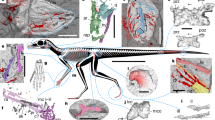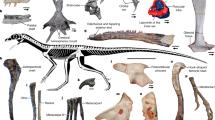Abstract
PLESIADAPIFORMES, of the North American and European Paleogene, is often identified as a sister group of primates. This hypothesis is based on several proposed anatomical synapo-morphies linking the best-known plesiadapiform families, Plesiadapidae, and Paromomyidae with Eocene primates1–5. The first well-preserved skull of Ignacius graybullianus, an early Eocene paromomyid plesiadapiform, clarifies and corrects previous cranial reconstruction based on more fragmentary material3,6,7. The new material indicates Plesiadapiformes are not Primates. Rather, several synapomorphies argue for a closer phylogenetic relationship between Plesiadapiformes and Cynocephalus, the extant flying lemur (order Dermoptera). In view of the finding that "archaic" primates are not cladistic Primates, the recently coined taxon "Euprimates" should be discarded. No support is lent by cranial anatomy to the hypothesis that Primates, tree shrews, bats and dermopterans form a clade Archonta.
This is a preview of subscription content, access via your institution
Access options
Subscribe to this journal
Receive 51 print issues and online access
$199.00 per year
only $3.90 per issue
Buy this article
- Purchase on Springer Link
- Instant access to full article PDF
Prices may be subject to local taxes which are calculated during checkout
Similar content being viewed by others
References
Gingerich, P. D. Univ. Mich. Pap. Paleont. 15, 1–141 (1976).
Russell, D. E. Mem. Mus. nat. Hist. 13, 1–324 (1964).
Szalay, F. S. Am. J. phys. Anthrop. 36, 59–76 (1972).
Szalay, F. S. Bull. Am. Mus. nat. Hist. 140, 193–330 (1969).
Szalay, F. S., Rosenberger, A. L. & Dagosto, M. Yb. phys. Anthrop. 30, 75–105 (1987).
MacPhee, R. D. E., Cartmill, M. & Gingerich, P. D. Nature 301, 509–511 (1983).
Rose, K. D. & Gingerich, P. D. Contrib. Mus. Paleont. Univ. Mich. 24, 181–189 (1976).
Gingerich, P. D. Wyoming Geol. Assn Guidbks 34, 185–195 (1983).
Szalay, F. S. & Delson, E. Evolutionary History of the Primates 1–580 (Academic, New York, 1979).
Novacek, M. J. Mammal. Rev. 7, 131–149 (1977).
MacPhee, R. D. E. & Cartmill, M. in Comparative Primate Biology: Systematics, Evolution and Anatomy (eds Swindler, D. & Erwin, J.) 219–275 (Alan R. Liss, New York, 1986).
Novacek, M. J. Bull. Am. Mus. nat. Hist. 183, 1–112 (1986).
Szalay, F. S. J. hum. Evol. 6, 3–18 (1977).
Hunt, R. M. & Korth, W. W. J. Morph. 164, 167–211 (1980).
Cartmill, M. in Phylogeny of the Primates: A Multidisciplinary Approach (eds Luckett, W. P. & Szalay, F. S) 313–354 (Plenum, New York, 1975).
Conroy, G. C. & Packer, D. J. Folia primatol. 35, 237–247 (1981).
Wible, J. R. Zool. J. Linn. Soc. 91, 107–135 (1987).
Wible, J. & Covert, H. H. J. hum. Evol. 16, 1–22 (1987).
Beard, K. C. thesis. The Johns Hopkins University. Baltimore, MD (1989).
Beard, K. C. Nature 345, 340–341 (1990).
Hoffstetter, R. C. r. hebd. Seanc. Acad. Sci., Paris (Ser. II) 302, 43–45 (1986).
MacPhee, R. D. E., Cartmill, M. & Rose, K. D. J. vert. Paleont. 9, 329–349 (1989).
Author information
Authors and Affiliations
Rights and permissions
About this article
Cite this article
Kay, R., Thorington, R. & Houde, P. Eocene plesiadapiform shows affinities with flying lemurs not primates. Nature 345, 342–344 (1990). https://doi.org/10.1038/345342a0
Received:
Accepted:
Issue Date:
DOI: https://doi.org/10.1038/345342a0
Comments
By submitting a comment you agree to abide by our Terms and Community Guidelines. If you find something abusive or that does not comply with our terms or guidelines please flag it as inappropriate.



